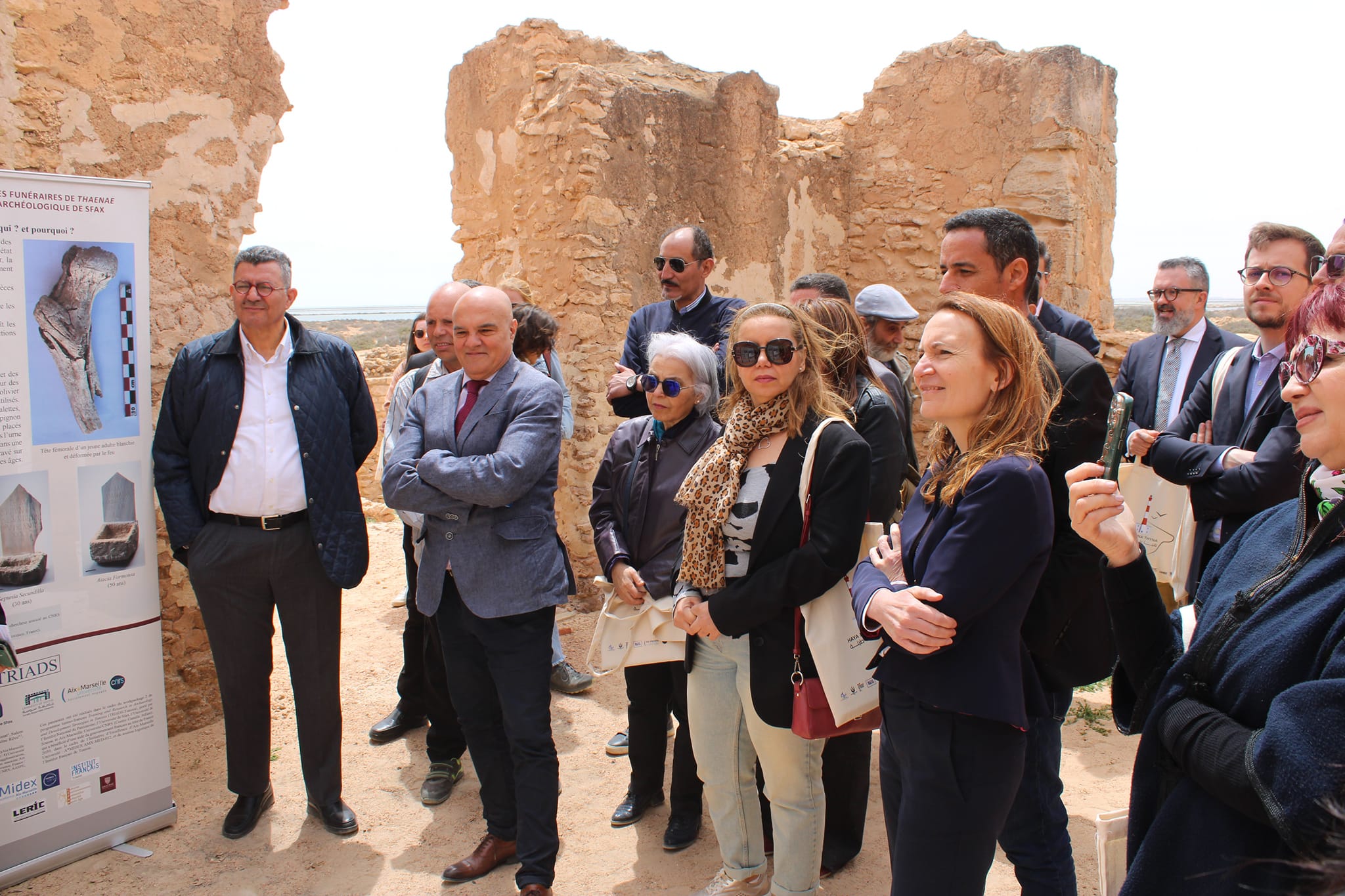
Inauguration of the “Let’s Go Thina” project for the protection, conservation and promoting of archaeological heritage
As part of the international cooperation between the National Heritage Institute, the University of Sfax and the University of Marseille, France, on the site of Thina in the governorate of Sfax, Mr Tarek Baccouche, Director General of the National Heritage Institute, Mrs Anne Guéguen, French Ambassador to Tunisia, Mr Fayez Gergouri, Vice-President of the University of Sfax, and Mr Sourisse, Director General of the National Heritage Institute, Mr Tarek Baccouche, Director General of the National Heritage Institute, Mrs Anne Guéguen, French Ambassador to Tunisia, Mr Fayez Gergouri, Vice-President of the University of Sfax, and Mr Sourisse, Director General of the National Heritage Institute, officially opened the “Let’s Go Thina” project. On Sunday 21 April 2024, Fayez Gergouri, Vice-President of the University of Sfax, and Sourisseay Jean Christophe of the University of Marseille oversaw the inauguration of the “Let’s Go Thina” project for the protection, conservation and promotion of archaeological heritage in southern Tunisia. The joint programme will run until 2026.
Since 2017, the Chantier-école de Thina project has provided 13 training courses for INP staff and students from Tunisian and French universities in the fields of archaeological research, inventory, study, documentation and enhancement.
In this context, the National Heritage Institute has received substantial logistical support from the French Institute in Tunis to make this project a success by acquiring cutting-edge material and equipment for training and archaeological research, using modern techniques for inventorying, surveying and documenting Tunisia’s cultural and cultic heritage.
The international exhibition “Africa and the Byzantine Empire” AFRICA AND BYZANTIUM” held in the United States of America
As part of Tunisia’s accompaniment to the international exhibition “Africa and the Byzantine Empire” AFRICA AND BYZANTIUM” held in the United States of America, in which our country contributes with a special archaeological collection. A delegation from the National Heritage Institute, headed by its Director General, Mr. Tarek Baccouche, traveled to inaugurate the second and final step of this exhibition, which will be held at the Cleveland Museum of Art. As a reminder, this international event organized by the Metropolitan Museum of New York and the Cleveland Museum of Art, in which many countries, including Tunisia, Egypt, Morocco, France and Greece, participate with an archaeological and historical collection of about 160 pieces dating between the fourth and fifteenth centuries AD, showing the close relationship between Africa and the Byzantine Empire from the founding of Constantinople until its fall by the Ottoman Empire.
The exhibition highlights the extent of African influence and its contribution to various aspects of Byzantine civilization, including culture, arts and religions. On this occasion, the Director General of the National Heritage Institute delivered the opening speech in which he praised the great effort of those who organized this event and all those who contributed to its success, stressing that “deep relations in the field of scientific and archaeological research are deep-rooted between Tunisia and the United States of America.He also emphasized that Tunisia has a large archaeological inventory that covers all historical periods of the country, spanning thousands of years.Perhaps this exhibition will be an opportunity for visitors to get to know a small part of this civilizational stock and motivate them to visit our archaeological and historical sites. I hope that this event will be a catalyst for more joint work agreements and exchange of experiences between the two countries in this field.
It is worth mentioning that the first stop of this exhibition took place at the Metropolitan Museum in New York City between November 19, 2023 and March 3, 2024, and was a great success with more than 190,000 visitors during that period. The officials of these two museums have on several occasions expressed their gratitude and thanks to the National Heritage Institute for its valuable contribution, recognizing its significant addition to the content of the exhibition. A large number of local newspapers and the media in general, whether in New York or Cleveland, focused on the Tunisian exhibits, which include a number of mosaics, including the “Lady of Carthage” mosaic, a collection of oil lamps and wall ceramics dating from the fourth to the seventh century AD, and copies of two manuscripts of the Quran from the manuscript laboratory in Regada dating from the eighth and ninth centuries AD.This international event is the first of its kind and the largest ever in this field in the United States of America.
Tunisian-Chinese cooperation in the cultural field
Within the framework of strengthening Tunisian-Chinese cooperation in the cultural field, the Chinese Association for International Understanding organized on Monday, December 25, 2023, in partnership with the Ministry of Cultural Affairs and the National Institute of Heritage, a symposium on civilizational exchanges between Tunisia and China, at the Palace Ksar Saïd, the Palace of Arts and Letters.